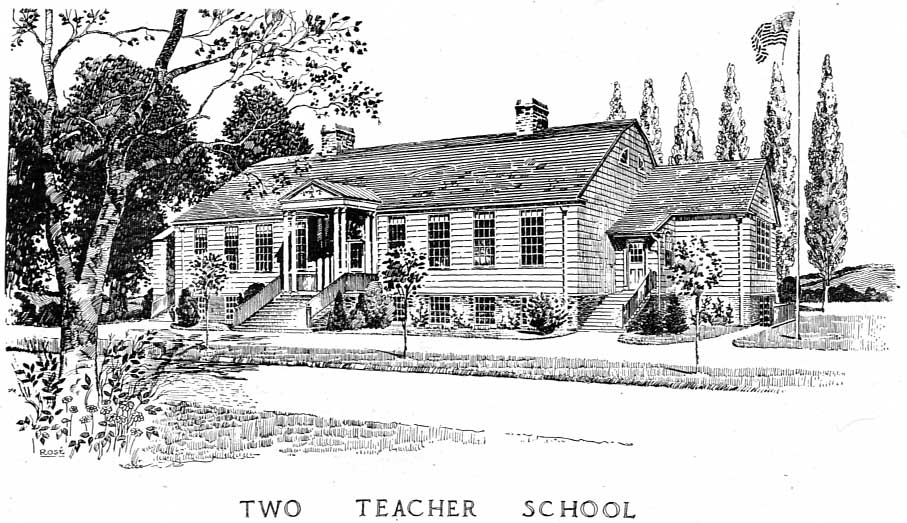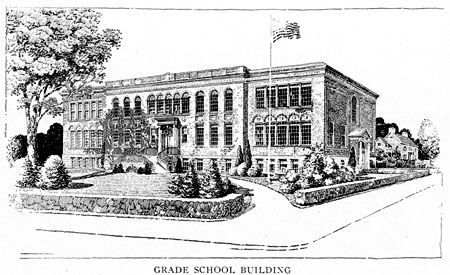The following excerpts are from a lengthy article by Betelle that appeared in The American Architect, Vol. CXVII, Number 2321, June 16, 1920. In it, he outlines the roots of Pierre S. duPont’s epic rural school-building plan for the State of Delaware and the civic, educational and personal benefits it would bring to the citizens of that State. Written before any of the structures were completed, the article was accompanied by beautiful pen & ink drawings and floor plans of many of the school designs.
New School Buildings, State of Delaware
By James O. Betelle, A.I.A.
Illustrated by the work of Guilbert & Betelle, Architects for the Delaware School Auxiliary Association, a corporation organized for the purpose of expanding the duPont Fund for new School Buildings to be built in the State of Delaware.
The school building program now in progress throughout the State of Delaware is at once the most interesting and probably the most important that has ever been undertaken by any state.
 It so happens that the State of Delaware is in a peculiarly suitable condition for such a far-reaching building program. In the first place it is small in area and the replacement of all the buildings in the State does not mean such an outlay in time or money as would be involved in practically any other State. Further, few, if any, new schools have been built in the State for the past twenty or thirty years. The majority of the school buildings are fifty to one hundred or more years old. Inasmuch as nearly all of the school buildings are obsolete and in many cases a menace to the health and safety of the children, the rearrangement of the buildings, their elimination in some instances and consolidation in others, means only the discarding of old buildings which should have been razed years ago, The situation was not complicated with a few new buildings at scattered points which were too good to be discarded. It is therefore possible to wipe the slate clean and make a new start. This means that the State will now have what almost amounts to an entirely new school building equipment, located and constructed along most modern lines.
It so happens that the State of Delaware is in a peculiarly suitable condition for such a far-reaching building program. In the first place it is small in area and the replacement of all the buildings in the State does not mean such an outlay in time or money as would be involved in practically any other State. Further, few, if any, new schools have been built in the State for the past twenty or thirty years. The majority of the school buildings are fifty to one hundred or more years old. Inasmuch as nearly all of the school buildings are obsolete and in many cases a menace to the health and safety of the children, the rearrangement of the buildings, their elimination in some instances and consolidation in others, means only the discarding of old buildings which should have been razed years ago, The situation was not complicated with a few new buildings at scattered points which were too good to be discarded. It is therefore possible to wipe the slate clean and make a new start. This means that the State will now have what almost amounts to an entirely new school building equipment, located and constructed along most modern lines.
It is not to be imagined that all this excellent work could have been done without some opposition. It was, of course known that the construction and maintenance of these improved school facilities would mean an increase in the tax rate. The citizens of the State of Delaware are no different from those of any other community, An increase in the tax rate means opposition from those to whom the present conditions seem “good enough.” The majority of the citizens, however, stood firmly back of the work for the betterment of the schools, and they were in the end successful.
While it was admitted that all these new buildings would be costly, especially at the present time, a way out of the difficulty was found in the person of Mr. Pierre S. duPont, who was appointed by the Governor a member of the State Board of Education which had been created by the new School Code. Mr. duPont belongs to that family of Delawareans which has done so much for the State, not only in roads and education. but in public improvements generally and in large business enterprises. It was through Mr. duPont’s generosity and vision that it was made possible to defray the cost of preliminary investigations of the educational system and school buildings of the State. It could hardly be expected that the State Legislature would make an appropriation for such a purpose with all the other urgent demands upon the State treasury, nevertheless, to make the results of such an investigation worth while, it was necessary to retain the services of the best experts, which were necessarily costly.
After the School Code was made a law and to serve to encourage the acceptance of this School Code by the various districts, Mr. Pierre S. duPont made a gift of the sum of $2,000,000, which was to be apportioned to the districts accepting the new School Code and to assist them in the construction of new school buildings. To handle the expenditure of this money the Delaware School Auxiliary Association was incorporated and Dr. Joseph H. Odell, the director of the Service Citizens of Delaware, was made its president. The principal duty of the Delaware School Auxiliary Association was to have charge of the expenditure of the duPont Fund and the able services of Dr. Odell and his associates of the Delaware school Auxiliary Association cannot properly be appreciated until later on when the results will undoubtedly speak for themselves.
Dr. Joseph H. Odell says, in speaking of Mr. duPont:
“Pierre S. duPont is not yet fifty years of age, a reticent and quiet man, whose outstanding characteristics to those who know him are a tremendous capacity for, organization, an intense love of flowers and trees, a passion for music and a fondness for seclusion in the rebuilt. ancient farmhouse which is his home. In the midst of the war, while he was president of the duPont de Nemours Corporation and was producing the larger part of the explosives that were blasting the German lines to pieces, he founded the Service Citizens of Delaware, an organization to study and make experiments which should improve vital conditions in the State–public health, education, housing and the general humanizing of human relationships. He set aside a million and a half dollars to finance this venture.”
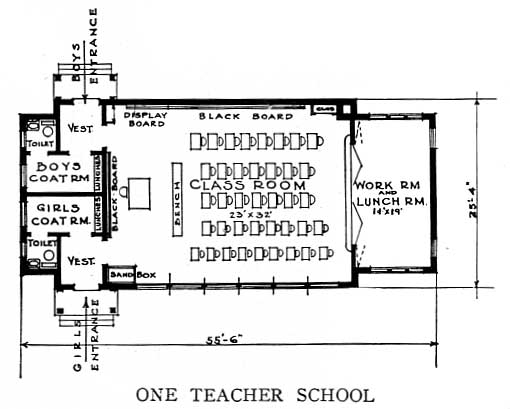 The architecture of small rural schools throughout the United States has notedly been very much neglected. These buildings, with but few exceptions, are unattractive and without elements of good taste or good architecture. The reason for this is readily understood, as these buildings were built by widely separated communities over a long period of years; the funds available and the importance of the work did not warrant the expense of competent architectural services that a larger building program in a limited area makes possible. The quality of the rural school building is, however, improving, and the instructive bulletins with standard plans that have been prepared by a number of the State Departments of Education and the U. S. Department of Rural Education, for free distribution to districts contemplating the erection of a new school building have contributed in a very large degree to this improvement.
The architecture of small rural schools throughout the United States has notedly been very much neglected. These buildings, with but few exceptions, are unattractive and without elements of good taste or good architecture. The reason for this is readily understood, as these buildings were built by widely separated communities over a long period of years; the funds available and the importance of the work did not warrant the expense of competent architectural services that a larger building program in a limited area makes possible. The quality of the rural school building is, however, improving, and the instructive bulletins with standard plans that have been prepared by a number of the State Departments of Education and the U. S. Department of Rural Education, for free distribution to districts contemplating the erection of a new school building have contributed in a very large degree to this improvement.
 Actual construction is now under way on three experimental One Teacher schools, all three different in plan and containing different items of equipment. It was thought wise to build these three schools and have them visited and criticized by everyone interested before starting in on a wholesale construction of the hundred or more small buildings needed throughout the State. Any mistakes in layout which showed up after the completion and use of these buildings or any improvements that may be suggested, could be taken advantage of and incorporated in the future buildings.
Actual construction is now under way on three experimental One Teacher schools, all three different in plan and containing different items of equipment. It was thought wise to build these three schools and have them visited and criticized by everyone interested before starting in on a wholesale construction of the hundred or more small buildings needed throughout the State. Any mistakes in layout which showed up after the completion and use of these buildings or any improvements that may be suggested, could be taken advantage of and incorporated in the future buildings.
A saving in equipment is also made possible in connection with traveling special teachers. In the back of the small automobile in which the teacher travels from school to school can be fitted a kitchen. Instruction can be given in this traveling class room or its equipment and materials moved into the workroom provided for it in the school building. As each school is a community centre and the class room available for lectures, etc., an automobile with moving-picture machine and reels, traveling from place to place, will be available. This automobile will be so constructed that it will generate electricity under its own power by which to show the pictures in remote districts where no electric current is available. This will bring the world’s news and some wholesome entertainment into the midst of a district which otherwise would be neglected.
One of the most serious problems in connection with efficiently regulating the schools in small communities and suburban localities has centred around the proper housing of its teachers. The problem in many places has indeed become acute and has adversely affected the grade of teacher that might be secured and retained. Many of the causes at present reducing the number of workers on the farms and in the small communities are also effecti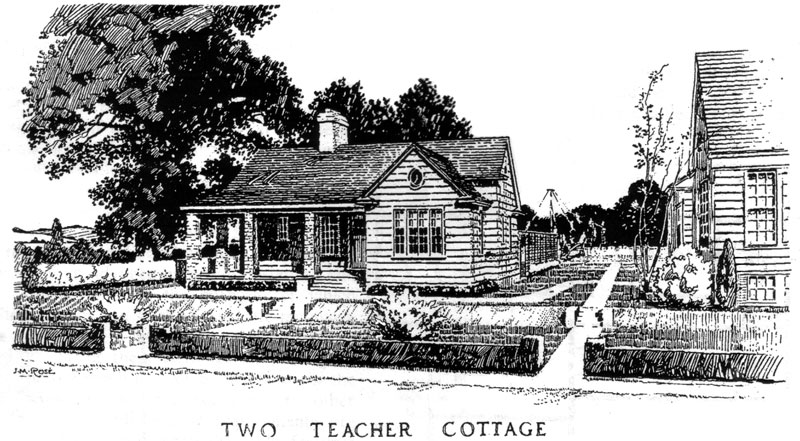 ve in the case of teachers. And just as better housing would be the chief factor in adjusting the farm labor problem, so would the whole community life be improved if its teachers might find surroundings in keeping with their work and temperament. Teachers themselves preach the doctrine of the importance of proper environment. Their own development is not immune from tis influence and a proper regard for community welfare demands that such environment be made available.
ve in the case of teachers. And just as better housing would be the chief factor in adjusting the farm labor problem, so would the whole community life be improved if its teachers might find surroundings in keeping with their work and temperament. Teachers themselves preach the doctrine of the importance of proper environment. Their own development is not immune from tis influence and a proper regard for community welfare demands that such environment be made available.
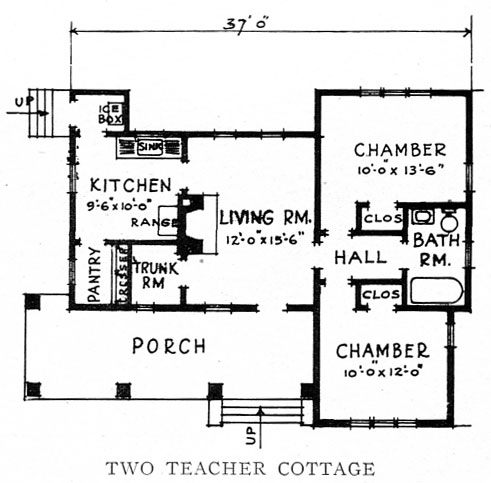 The real solution of the problem has been the teacher’s cottage or “Teacherage”, as it is often called. It fills the purpose for the school that the “Rectory” does for the church, only it is really more necessary. Foreign countries have long recognized and met this need, but only recently have we in this country done anything toward its solution. An attempt has been made to build the school with living quarters for the teachers on the upper floor. This has been found to have many undesirable features and some State laws forbid any living quarters to be combined with the school building. With these things in mind, the architect at the present development has provided for the construction on the school property of small houses so designed as to afford housing for teachers that would attract dignified and worthy representative of that important profession. As would naturally be inferred, the design of these cottages has followed along the lines of the school buildings of which they become part. Illustrations of such cottages accompany this article.
The real solution of the problem has been the teacher’s cottage or “Teacherage”, as it is often called. It fills the purpose for the school that the “Rectory” does for the church, only it is really more necessary. Foreign countries have long recognized and met this need, but only recently have we in this country done anything toward its solution. An attempt has been made to build the school with living quarters for the teachers on the upper floor. This has been found to have many undesirable features and some State laws forbid any living quarters to be combined with the school building. With these things in mind, the architect at the present development has provided for the construction on the school property of small houses so designed as to afford housing for teachers that would attract dignified and worthy representative of that important profession. As would naturally be inferred, the design of these cottages has followed along the lines of the school buildings of which they become part. Illustrations of such cottages accompany this article.
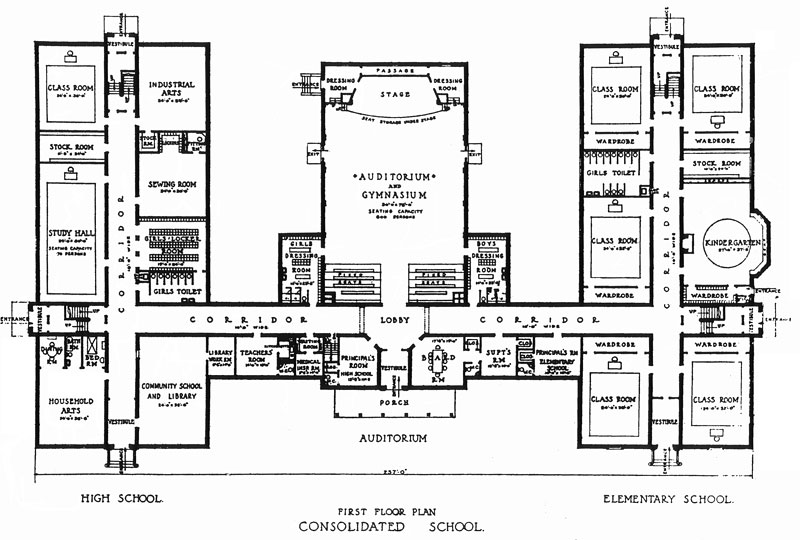 While perfection is not claimed for any of the plans of the school buildings illustrated, it is claimed that they show an advance in school designing and that the exteriors express the purpose for which the building is built and at the same time making a workable school and a building of good architectural quality. While these buildings were designed especially for the condition to be met with in the State of Delaware and may not apply to other States where the conditions or requirements are different, they do contain many desirable features that might be taken advantage of for new schools to be built anywhere It is hoped that the new building program in the State of Delaware will contribute its part to the general improvement in school design.
While perfection is not claimed for any of the plans of the school buildings illustrated, it is claimed that they show an advance in school designing and that the exteriors express the purpose for which the building is built and at the same time making a workable school and a building of good architectural quality. While these buildings were designed especially for the condition to be met with in the State of Delaware and may not apply to other States where the conditions or requirements are different, they do contain many desirable features that might be taken advantage of for new schools to be built anywhere It is hoped that the new building program in the State of Delaware will contribute its part to the general improvement in school design.
The outlook for the school children in the State of Delaware is a bright one, In a few years time they will all be housed in new school buildings where it will be possible to give proper instruction under first-class teachers. While the present conditions are not all they should be, the defects are known and the remedy is available. The results will justify all the labor and money spent and make healthier and better educated citizens for the “Diamond State” and indirectly benefit the nation as a whole.


